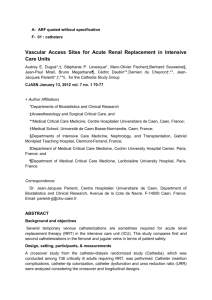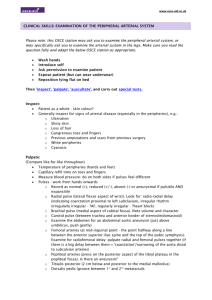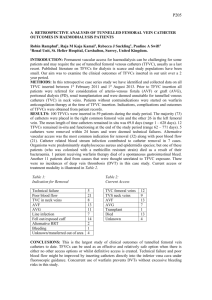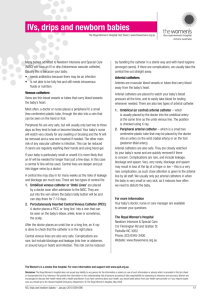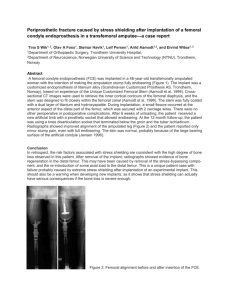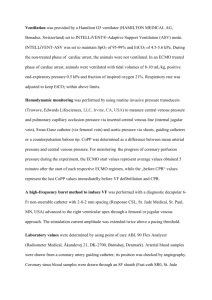Early Mobility and Walking for Patients with Femoral Arterial
advertisement
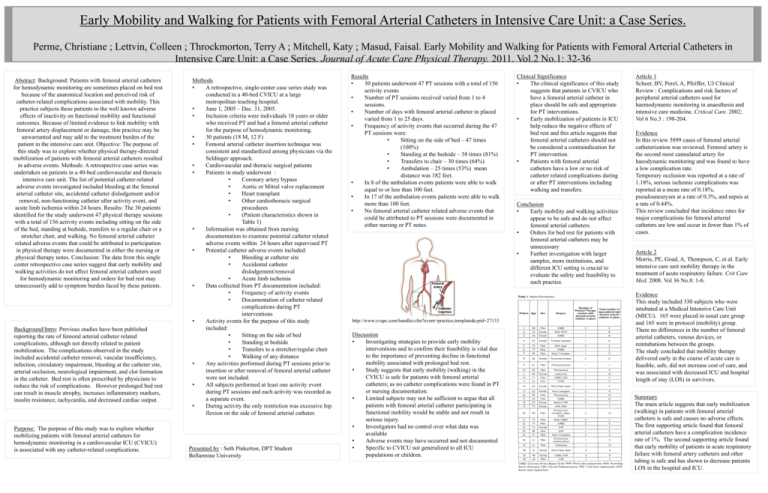
Early Mobility and Walking for Patients with Femoral Arterial Catheters in Intensive Care Unit: a Case Series. Perme, Christiane ; Lettvin, Colleen ; Throckmorton, Terry A ; Mitchell, Katy ; Masud, Faisal. Early Mobility and Walking for Patients with Femoral Arterial Catheters in Intensive Care Unit: a Case Series. Journal of Acute Care Physical Therapy. 2011. Vol.2 No.1: 32-36 Abstract: Background: Patients with femoral arterial catheters for hemodynamic monitoring are sometimes placed on bed rest because of the anatomical location and perceived risk of catheter-related complications associated with mobility. This practice subjects these patients to the well known adverse effects of inactivity on functional mobility and functional outcomes. Because of limited evidence to link mobility with femoral artery displacement or damage, this practice may be unwarranted and may add to the treatment burden of the patient in the intensive care unit. Objective: The purpose of this study was to explore whether physical therapy-directed mobilization of patients with femoral arterial catheters resulted in adverse events. Methods: A retrospective case series was undertaken on patients in a 40-bed cardiovascular and thoracic intensive care unit. The list of potential catheter-related adverse events investigated included bleeding at the femoral arterial catheter site, accidental catheter dislodgement and/or removal, non-functioning catheter after activity event, and acute limb ischemia within 24 hours. Results: The 30 patients identified for the study underwent 47 physical therapy sessions with a total of 156 activity events including sitting on the side of the bed, standing at bedside, transfers to a regular chair or a stretcher chair, and walking. No femoral arterial catheter related adverse events that could be attributed to participation in physical therapy were documented in either the nursing or physical therapy notes. Conclusion: The data from this single center retrospective case series suggest that early mobility and walking activities do not affect femoral arterial catheters used for hemodynamic monitoring and orders for bed rest may unnecessarily add to symptom burden faced by these patients. Background/Intro: Previous studies have been published reporting the rate of femoral arterial catheter related complications, although not directly related to patient mobilization. The complications observed in the study included accidental catheter removal, vascular insufficiency, infection, circulatory impairment, bleeding at the catheter site, arterial occlusion, neurological impairment, and clot formation in the catheter. Bed rest is often prescribed by physicians to reduce the risk of complications. However prolonged bed rest can result in muscle atrophy, increases inflammatory markers, insulin resistance, tachycardia, and decreased cardiac output. Purpose: The purpose of this study was to explore whether mobilizing patients with femoral arterial catheters for hemodynamic monitoring in a cardiovascular ICU (CVICU) is associated with any catheter-related complications. Methods • A retrospective, single-center case series study was conducted in a 40-bed CVICU at a large metropolitan teaching hospital. • June 1, 2005 – Dec. 31, 2005. • Inclusion criteria were individuals 18 years or older who received PT and had a femoral arterial catheter for the purpose of hemodynamic monitoring. • 30 patients (18 M, 12 F) • Femoral arterial catheter insertion technique was consistent and standardized among physicians via the Seldinger approach. • Cardiovascular and thoracic surgical patients • Patients in study underwent : • Coronary artery bypass • Aortic or Mitral valve replacement • Heart transplant • Other cardiothoracic surgical procedures • (Patient characteristics shown in Table 1) • Information was obtained from nursing documentation to examine potential catheter related adverse events within 24 hours after supervised PT • Potential catheter adverse events included: • Bleeding at catheter site • Accidental catheter dislodgement/removal • Acute limb ischemia • Data collected from PT documentation included: • Frequency of activity events • Documentation of catheter related complications during PT interventions • Activity events for the purpose of this study included: • Sitting on the side of bed • Standing at bedside • Transfers to a stretcher/regular chair • Walking of any distance • Any activities performed during PT sessions prior to insertion or after removal of femoral arterial catheter were not included. • All subjects performed at least one activity event during PT sessions and each activity was recorded as a separate event. • During activity the only restriction was excessive hip flexion on the side of femoral arterial catheter. Presented by : Seth Pinkerton, DPT Student Bellarmine University Results • 30 patients underwent 47 PT sessions with a total of 156 activity events • Number of PT sessions received varied from 1 to 4 sessions. • Number of days with femoral arterial catheter in placed varied from 1 to 25 days. • Frequency of activity events that occurred during the 47 PT sessions were: • Sitting on the side of bed – 47 times (100%) • Standing at the bedside – 38 times (81%) • Transfers to chair – 30 times (64%) • Ambulation – 25 times (53%) mean distance was 182 feet. • In 8 of the ambulation events patients were able to walk equal to or less than 100 feet. • In 17 of the ambulation events patients were able to walk more than 100 feet. • No femoral arterial catheter related adverse events that could be attributed to PT sessions were documented in either nursing or PT notes. http://www.cvapc.com/handler.cfm?event=practice,template&cpid=27133 Discussion • Investigating strategies to provide early mobility interventions and to confirm their feasibility is vital due to the importance of preventing decline in functional mobility associated with prolonged bed rest. • Study suggests that early mobility (walking) in the CVICU is safe for patients with femoral arterial catheters; as no catheter complications were found in PT or nursing documentation. • Limited subjects may not be sufficient to argue that all patients with femoral arterial catheter participating in functional mobility would be stable and not result in serious injury. • Investigators had no control over what data was available • Adverse events may have occurred and not documented • Specific to CVICU not generalized to all ICU populations or children. Clinical Significance • The clinical significance of this study suggests that patients in CVICU who have a femoral arterial catheter in place should be safe and appropriate for PT interventions. • Early mobilization of patients in ICU help reduce the negative effects of bed rest and this article suggests that femoral arterial catheters should not be considered a contraindication for PT intervention. • Patients with femoral arterial catheters have a low or no risk of catheter related complications during or after PT interventions including walking and transfers. Conclusion • Early mobility and walking activities appear to be safe and do not affect femoral arterial catheters. • Orders for bed rest for patients with femoral arterial catheters may be unnecessary • Further investigation with larger samples, more institutions, and different ICU setting is crucial to evaluate the safety and feasibility to such practice. Article 1 Scheer, BV, Perel, A, Pfeiffer, UJ Clinical Review : Complications and risk factors of peripheral arterial catheters used for haemodynamic monitoring in anaesthesia and intensive care medicine. Critical Care. 2002; Vol 6 No.3 : 198-204. Evidence In this review 3899 cases of femoral arterial catheterization was reviewed. Femoral artery is the second most cannulated artery for haeodynamic monitoring and was found to have a low complication rate. Temporary occlusion was reported at a rate of 1.18%, serious ischemic complications was reported at a mean rate of 0.18%, pseudoaneurysm at a rate of 0.3%, and sepsis at a rate of 0.44%. This review concluded that incidence rates for major complications for femoral arterial catheters are low and occur in fewer than 1% of cases. Article 2 Morris, PE, Goad, A, Thompson, C, et al. Early intensive care unit mobility therapy in the treatment of acute respiratory failure. Crit Care Med. 2008. Vol 36 No.8: 1-6. Evidence This study included 330 subjects who were intubated at a Medical Intensive Care Unit (MICU). 165 were placed in usual care group and 165 were in protocol (mobility) group. There no differences in the number of femoral arterial catheters, venous devices, or reintubations between the groups. The study concluded that mobility therapy delivered early in the course of acute care is feasible, safe, did not increase cost of care, and was associated with decreased ICU and hospital length of stay (LOS) in survivors. Summary The main article suggests that early mobilization (walking) in patients with femoral arterial catheters is safe and causes no adverse effects. The first supporting article found that femoral arterial catheters have a complication incidence rate of 1%. The second supporting article found that early mobility of patients in acute respiratory failure with femoral artery catheters and other tubing is safe and has shown to decrease patients LOS in the hospital and ICU.


